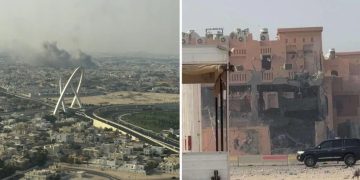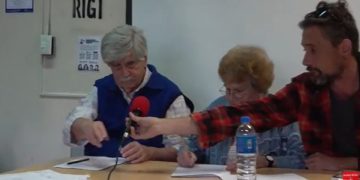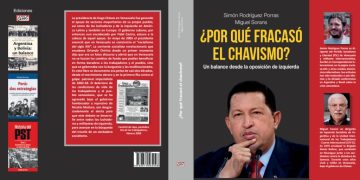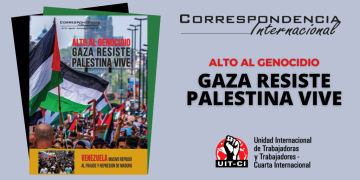The crisis of the revolutionary leadership, that is, its absence and the dominance of the counter-revolutionary apparatuses, although weaker, is what makes that despite the great revolutionary upsurge, imperialist dominion continues and revolutions do not move to socialist revolutions.
As noted by Nahuel Moreno, «while the proletariat does not overcome its crisis of revolutionary leadership it will not be able to defeat the world imperialism and all its struggles, as a result, will be full of victories that will lead inevitably to catastrophic defeats. (…) As apparatuses continue to control the mass movement, any revolutionary triumph is inevitably transformed into defeat.» (Transition Program Update, Thesis II). This is the danger that looms over the Arab revolutions, that the bourgeois and reformist Islamic and non-Islamic leaderships want to freeze or defeat. Therefore the number task one of the revolutionary socialists remains the struggle to overcome this crisis of leadership, building revolutionary parties in each country and a revolutionary International.
A rebellion of the underdog
The growth process of the global political revolution in the labour and popular movement which opened in 1989 with the fall of Stalinism is the factor that more strongly contributes to fight the fight for a new revolutionary socialist leadership. We define as political revolution the anti-bureaucratic rebellion and overflow of the rank and file of the old and the new bourgeois or union apparatuses. It has different expressions in all latitudes, starting with the Arab revolution, the rebellion of peoples over their leaderships, the youth who occupy Squares, demanding democracy and that works in mass meetings and rejects the old and new apparatuses such as «Indignados» in Spain and other parts of Europe or the United States. The labour strikes in some cases overflowing or against the union bureaucracies, from Europe, China to Latin America. O political ruptures from below, of clusters of the masses, in strikes or in indigenous and popular demonstrations as, for example, with centre-left governments as Evo Morales’ MAS or of the Peronist Cristina Kirchner.
At this stage after the collapse of Stalinism, no leaderships or leaders arise of the weight of Guevara, the Castro regime of the first hour nor of Mao and Maoism, which for decades dominated large sections of the masses and their vanguard.
The revolutionary upsurge highlights the betrayals of the leaderships. Of the leaderships arising from the 1990s, some stepped back (Yeltsin was removed from power, Walesa almost disappeared from the political scene in Poland and almost nobody remembers Marcos) and others no longer appear as an option, as was the case of Lula and the PT and the neo-reformism that grouped together in the World Social Forum (WSF) in Porto Alegre with its slogan «Another world is possible», as part of the 1990s anti-globalization movement. On the other hand, it also ended up liquidating former nationalist and secular Arab sectors (Gaddafi, Mubarak, Ben Ali or Bashar al-Assad of Syria), supported by the Castro-Chavism. The capitalist crisis and the revolutionary upsurge also laid bare the Islamist currents that since the Iranian revolution of the 1980s emerged as a political alternative, since they gave no support to the revolutions or did so at the end when their victory was inevitable. Its current political recovery, via the election results, will be circumstantial because they will eventually show their counter-revolutionary role to the masses
The Arab revolutions have revealed again the phenomenon of the leadership vacuum. In the sense that the masses make revolutions, dictators fall, but they find no political alternative either reformist or revolutionary. The youth, workers and popular sectors burst, mass meeting method prevails, but no clear leaders emerge or dominant political or union organizations. In the case of the Arab revolutions, this vacuum is filled circumstantially and partly by bourgeois or old leaderships which are recreated as Islamic parties (Muslim Brotherhood and others). But the continuity of the revolutionary process calls into question those leaderships and those governments as it happens with inequalities in Egypt or Tunisia.
The crisis of the Castro-Chavism has begun
The political current that Hugo Chavez headed, backed by Fidel and Raul Castro, is the one that had most impact in Latin America and around the world after the fall of the Berlin Wall and the former USSR. With his anti-U.S. and pro-socialist revolution discourse he managed to regroup a new neo-reformism, uniting scattered and beaten forces of former Stalinist Communist Parties «friends of Moscow».
But in recent years began, even with Chavez still alive, a setback after exposing its bourgeois and reformist roots. For example, he lost a lot of weight in the revolutionary vanguard of the countries of North Africa and the Middle East, for his outspoken support for dictators like Qaddafi and Bashar al-Assad. It was also a terrible blow his delivery to the Colombian government of FARC members, especially Perez Becerra. In Venezuela and Latin America, the crisis is even more mediated because, despite his anti-worker policies in his country, he was able to maintain his popularity with popular patronage politics based on high oil prices. But even before his death there were many signs of discontent and working class and popular protests, despite his electoral victories. Chavez’s absence causes a great void that Maduro or any other Venezuelan Chavism leader can hardly fill. A Chavism without Chavez will have to deal directly with the masses, without having its leader to buffer the application of the pro-bosses adjustments. The same applies at international level, because the other figures of Castro-Chavism are Evo Morales and the Cuban Castro leadership, and both have strong elements of crisis.
For years Castroism has not had the impact on the global vanguard that it had in the 1960/70s. On the contrary, the wear of Castroism accelerated in recent years, with the signs of decay already evident since the process of capitalist restoration in the island against what were the achievements of the Cuban revolution. It suffices to recall the confused statement by Fidel expressing: «not even we defend the model …» Exactly, his alliance with Chavez allowed the Castros to mend a little the political deterioration and loss of authority.
On the other hand, Evo Morales and his government are the most advanced point in the crisis of Castro-Chavism, who in recent years was faced with different strikes and popular and peasant-indigenous mobilizations. It is no coincidence that it was the COB which launched the formation of a Workers Party, a fact of importance in the fight for class independence in Latin America and the world.
There is a wide vanguard of workers, youth and the people
There are thousands of fighters emerging in the world who lead the demonstrations, the strikes, insurrections and revolutions, who are the raw material to fight for the development and construction of a new revolutionary leadership. There emerges an immense worker, popular and youth vanguard that heads the Arab revolutions and gives their life against the Syrian dictatorship, it mobilizes by the thousands as the «Indignados» or faces union bureaucracies in the world. It is a new generation of fighters who does not abide by the orders of Chavez or Fidel Castro to not defeat Gaddafi or face the Syrian dictator. For them, the focus is the revolutionary mobilization against dictators, mass meetings, grassroots democracy and against orders from above.
It is the combination of the confusion in the consciousness of the post-Stalinist stage and the weakness of the Trotskyist movement which prevents this vanguard to consciously adopt the banner of the Program of Permanent Revolution and the fight for worker governments. In turn, it is the sheer scale and militancy of this world vanguard what opens up the potential for the revolutionary to fight and connect with them to build the revolutionary parties that we need.
Objectively, they are thousands upon thousands of revolutionaries, although until now, there do not emerge currents clearly organized in revolutionary political organizations. But we have to be also open that they will finally do.
Of course we need to know that we do not act alone but that vanguard, as well as broad grassroots sectors, in their rejection of traditional apparatuses, tends to a variety of positions that start positively with anti-capitalism, anti-system and range to horizontalism and anti-partyism.
Also the apparatuses do not retire, but try to be recycled. For example, in the assemblies of the «Indignados» in Spain, emerged spokespeople for the reformists trying to influence, emerged anarchists sectors, and so on. In other words, there is a fight for the leadership that we revolutionary socialists have to give with specific policies. We are faced to the opportunist currents, including revisionists (USec, Mes-Marea) and Trotskyist sectarian. The first enters the movement giving up to the leaderships. And the other, with their self-proclaiming propagandism, rejects all unity of action to mobilize.
In that sense, we should stay away from any sectarianism and continue to push the various unity tactics, including in that appeal the different sections of the left and Trotskyism. For common points of trade union, democratic or anti-imperialist mobilisation (as for example, unity of action in support of the Syrian revolution, a labour strike or in an anti-bureaucratic labour front) or leftist political unities of the left (electoral or otherwise), as the case of the Front of the Left and the Workers (FIT) of Argentina or other political variants toward class independence, as the promoting with other sectors of the PT in Bolivia.
The unity of action and the unity of revolutionaries
The task of overcoming the crisis of revolutionary leadership and building a new leadership is not simple, but it is essential. And the revolutionary reality gives us new and better possibilities to continue giving the fight. We have to take advantage, with specific policies and tactics, of the opportunities of the class struggle (strikes, popular uprisings, student or youth mobilisations) or political-electoral opportunities against abstention, for tactics of unity of action for the various tasks (union, political, democratic, anti-imperialist, anti-capitalist) and of unity of the left for the electoral opportunities.
Opening organizational bridges between the vanguard and the parties adapted to each reality, with initiatives and organizational tactics of broad union groupings (CCURA of Venezuela, Unidos pra Lutar of Brazil or the Burgundy union ticket of rail workers in Argentina), as well as youth or popular. Open to the new, to the emergence of left breaks in bourgeois nationalist movements, of centre-left or Islamic and to new groupings or political realignments.
For example, in Bolivia it is essential to support and promote the formation of the PT voted by the COB. The possibility of the emergence of a mass workers party would also impact on the workers and the youth in Latin America and the world.
The revolutionary socialists must also be alert to the emergence of new revolutionary groupings. In this regard, the tactic of the Revolutionary United Front, of unity of the revolutionaries towards a revolutionary party and common international organization may have more presence.
The growing rise of labour and youth struggles in Europe and its links with the Arab revolution, its strategic importance for the development of the world revolution, confirms the importance for the IWU-FI, with most of its forces in Latin America, to prioritize the European continent and the relations and political exchange with revolutionary organizations that have important coincidences.










































